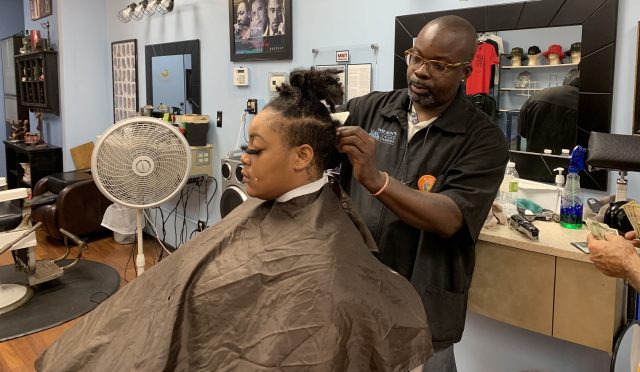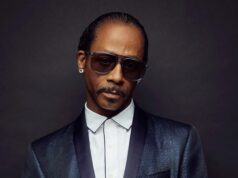By – Behindthechair.com
First published: 11 June 2020.
Why Are Textured Hairstylists In Fashion & Film So Scarce?
In early 2019, celebrity and editorial stylist Lacy Redway (@lacyredway) posted an Instagram video of someone from her team braiding hair at NYFW to comment on the significant lack of hairdressers backstage at runway shows with the skill set to braid or style Black hair. This was in reference to a viral video by model Olivia Anakwe, where no hairstylist backstage could cornrow her hair—and someone on the nail team had to step in.
“Can we talk about this?” Lacy asked in the post. “I don’t think we can see change happen if we aren’t talking about it so that we can all understand each other’s point of views.
I’ve been that other stylist many times before who has had to ‘come to the rescue’. Think about how that woman feels knowing that it is your job to do her hair, yet you don’t care enough to learn about her texture. It’s unacceptable,” Naeemah LaFond (@naeemahlafond), amika Global Artistic Director, told BTC last year. “The responsibility is two-fold. It lies with each stylist to make sure that they are equipped to do the job that they were booked for, and with brands and agencies to also take on a more diverse portfolio of artists.”
Now, with a global conversation taking place about racism and inequality, the beauty industry is closely scrutinizing how Black hairdressers—and their clients—are represented. Combined with a frustrating lack of textured hair knowledge across the pro industry, the issues of Black representation can no longer be minor ones. Now, the industry as a whole is recognizing its lack of inclusion, and taking steps to make change.
Last week, Naeemah shared her guide on how brands and industry decision makers can support Black hairstylists. “I’ve made a list of action steps that decision makers and leaders can follow in making a real change in our industry that goes beyond a social media post,” Naeemah said. “We are at a historical moment and I along with many of my peers are open to having this conversation with you (as awkward as it may get) so that we can advance as an industry in a way that is in true representation of all of its artists.”
Last year BTC spoke to a few Black industry leaders and celebrity stylists to get their take on this issue and what can be done to correct it. Here are three takeaways on why inclusion is so important and how the beauty industry can influence change right now:
1. Texture Education Should Become Mandatory For ALL Stylists
Many white stylists are not educated on working with textured hair. “The problem is that they don’t take the time out to learn how to work with textured hair,” says celebrity and editorial stylist Takisha Sturdivant-Drew (@takishahair). “But on the other hand, African American women and men have to know how to do all textures across the board.”
The issue starts in cosmetology school. Even MIZANI Global Artistic Director Tippi Shorter (@tippishorter) recalls spending only a few days on textured hair at her beauty school in the ’90s. “We spent three days learning how to relax and press out Black hair. None of the instructors taught us, so they actually outsourced it. They hired a stylist from a local salon who taught us how to straighten and relax hair out of the 1,600 hours of beauty school.”
“[Textured hair is] not something that people usually learn in cosmetology school, because things kind of change when it pertains to multi-textured hair,” adds celebrity and editorial hairstylist Kim Kimble (@kimblehaircare). It’s up to beauty schools to change their curriculum to equip future stylists with education in all textures of hair.
And once school is over, continuing education is key. “I think it’s about time that all stylists diversify their portfolio of the services they provide. We live in a multicultural world with more than half of the population having curly hair,” shares Matrix Artistic Director and The Salon By InStyle Creative Director Michelle O’Connor (@michelleoconnorbeauty).
“I think it would be great for the union to have an element of education for stylists to school them on how to properly take care of textured hair,” says celebrity stylist Larry Sims (@larryjarahsims) on how industry leaders in fashion and film can support the change. Michelle adds, “We have the power as hairdressers to desegregate the beauty industry and make it a community where there are more salons that are inclusive and cater to everyone.”
Until every hairstylist is knowledgeable in curly and coily hair, hire Black hairdressers to fill the roles. “The most experienced and skilled natural hair stylists must be hired to be on set, beyond an initial informal consulting briefing and skill has to become the merit. Texture styling requires patience to acquire the skill set and experience to be competent in this hair space,” says says MIZANI Global Artistic Director and Ulta Beauty Pro Team Member Pekela Riley (@pekelariley). “When the industry as a whole is this far behind, authentic natural hairstylists that have lived and thrived in this space must be hired to know how to get it right.”
2. Be Intentional With Hiring Black Hairdressers
A few of Naeemah’s points call to normalize hiring Black creatives, but not just as freelancers when Black talent is involved. Hire Black hairdressers as lead stylists, add them to your creative teams and don’t just regulate them to ONLY doing textured hair when their skill set is broader.
“I think the decision makers (producers, photographers, executives, etc.) should remove their biases and consider the bigger picture,” says celebrity, editorial and runway stylist Nai’vasha Johnson (@naivashashaintl). “The bigger picture is the creative excellence of all parties involved and the employment of talented artists of color who belong in those creative spaces to execute a body of work that we all can feel proud and confident about.”
Many Black artists can recall some point in their career where they wanted to advance, but felt stuck because casting agents, creative directors, brands, etc. couldn’t see past their skin tone. “I always wanted to do editorial,” recaps MIZANI Artist and celebrity stylist Jamal Edmonds (@lamajbackwards). “One agency I called, they weren’t really responsive—but one day out of the blue they called, they said ‘Hey, we want you to come work on set for us. It will be led by this great hairstylist.’ When I got there, it was all Black women with textured hair and they just needed me as an assistant to straighten their hair.”
If you’re a stylist that wants to do celebrities like Kim Kimble, stylist to pop stars like Beyoncé and Nicki Minaj, getting your foot in the door isn’t easy. “Not anybody can just come and start working in entertainment for hair. It’s a closed, specialized field and you need to be educated in that,” Kim told BTC. “It is not something you can just pay to get into, you have to be invited in.”
Sadly Black hairdressers find themselves either being called to only do Black hair or overlooked completely for projects with Black talent. “A few things that I have noticed in this industry is if you don’t have an elite status of clients on your roster for booking ‘champagne’ jobs or editorial work, oftentimes the team viewing your work will choose the artist that is extremely talented, however not the right fit for the particular job,” says editorial and celebrity stylist Kendall Dorsey (@kendalldorsey1).
3. Lack Of Texture Knowledge Means The Client Suffers
When a model or a client sits in a hairdresser’s chair and is told that hairdresser doesn’t know how to do her hair type, that’s a problem. “There is nothing worse than not feeling your best before being filmed or photographed,” says Larry.
Tippi adds, “I have been the stylist that has been called to come in and work on the Black models at Fashion Week on an all-white team. So, I would be there alone working on one to four models who were told to wait for Tippi.”
Some models and actors have confessed to getting their hair done before showing up to work. Kendall had this to say, “There has been a plethora of times that models have come to my studio to be prepared before the shoot, because they have hired someone that caters to a totally different hair texture and market.”
Some hairdressers like celebrity stylist Tym Wallace (@tymwallacehair) intentionally work with Black talent, because of the lack of hairstylists in the entertainment industry. “I believe that the opportunities are mostly only given to my counterparts, because we (people of color) have to prove our artistry and that’s not fair. I am an artist and I work with all hair types and races, but as of now my mission is to cater to ethnic women because of the lack of artists and representation.”
Source: https://behindthechair.com/articles/where-are-all-the-black-hairstylists-in-fashion-film/










